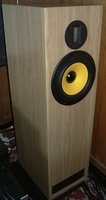First off my Amp right now can supply 80 watts RMS per channel just fine, I figured I'm usually pushing mid 40's with no distortion. But now I have a pair of Klipsch RP-280F's coming in, which are very efficient and with my current room will have no issue being powered with what I have.
But I want to have something to crank these things to get the cops called on me, especially when the new Star Wars releases in a month. I'm looking for a Power Amp that can push high 100's to mid 200's RMS and handle those peaks for when these things want to pull 400watts. The problem is the higher quality Power Amps cost an arm and a leg.
So am I stuck getting something like Emotiva's or are there better power amps (cost respective) out there?
But I want to have something to crank these things to get the cops called on me, especially when the new Star Wars releases in a month. I'm looking for a Power Amp that can push high 100's to mid 200's RMS and handle those peaks for when these things want to pull 400watts. The problem is the higher quality Power Amps cost an arm and a leg.
So am I stuck getting something like Emotiva's or are there better power amps (cost respective) out there?
![[H]ard|Forum](/styles/hardforum/xenforo/logo_dark.png)

